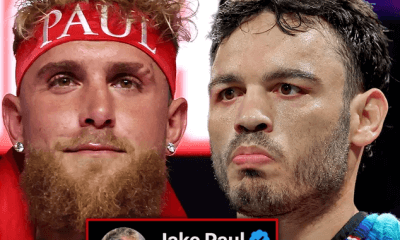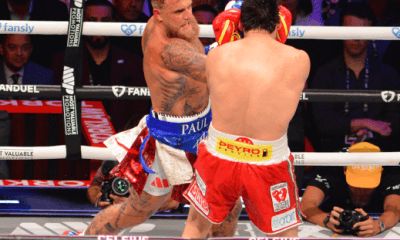Featured Articles
LA Area Fighters Leo Santa Cruz and John Molina Still Swinging

Two Southern California based prizefighters known for their longtime preference for slugging over slickness, will take center stage.
Both have withstood years of punishment with their battering styles and surprisingly remain staunchly relevant in the fight game despite the years of punishment endured in some of the most brutal fights in the past decade.
WBA featherweight titlist Leo Santa Cruz (35-1-1, 19 KOs) defends against Rafael Rivera (26-2-2, 17 KOs) and welterweight John Molina (30-7, 24 KOs) meets undefeated Omar Figueroa (27-0-1, 19 KOs) at the Microsoft Theater in downtown L.A. Fox will televise the PBC fight card.
The two Los Angeles area prizefighters are not the only pugilists who use aggressiveness over slickness, but they are among the few who still manage to go to war with a fighting style that requires toughness, grit and resilience after so many years.
Santa Cruz, 30, comes from a fighting family whose brothers Jose Armando, Antonio and Roberto all put on the gloves.
The East Los Angeles native has been fighting since 2006 with his nonstop punching mode that has enabled him to win world titles as a bantamweight, super bantamweight and twice as a featherweight.
Even before his professional debut Santa Cruz was engaging in wars inside gyms with older, bigger boxers on a daily basis. They’re the kind of sparring battles that can sap the strength out of the strongest men both physically and mentally. Punishment like this can debilitate even the best over time like a hammer chiseling away the hardest granite.
But despite all the hammering Santa Cruz has endured in sparring sessions and prize fights, the rail thin featherweight with the jet black hair remains at the top of the pile in his weight division.
Now Santa Cruz faces Rivera, a dangerous Tijuana fighter who replaces Miguel Flores the original opponent felled by injury. Entering his 13th year as a pro the featherweight champion has bludgeoned his way to the top and remains king of the mountain.
“Leo is just gifted. He wears you down. Certain fighters are given this type of ability. Guys like Sugar Shane Mosley, Floyd Mayweather, Manny Pacquiao they are just born with these gifts,” said Rudy Hernandez who worked with two Santa Cruz brothers as a trainer and cut man.
On Saturday, Leo Santa Cruz makes the third defense of the WBA title since reclaiming it from England’s Carl Frampton in January 2017. Before that, he held it for one defense after beating Abner Mares for the first of two times.
“We were getting ready for Miguel Flores, but in the gym you have to always be ready for any kind of style. We had been already been working with sparring partners who brawl, and that’s what we expect from Rafael Rivera,” said Santa Cruz in Los Angeles on Thursday. “He can take punches, so we’re ready for 12 rounds. We’re going to be smart in this fight because we know what Rivera can do.”
Rivera has already built a reputation as not just a brawler but someone with enough talent and power to upend the future aspirations of Santa Cruz. In his last fight in downtown L.A. he nearly toppled undefeated Joet Gonzalez. He’s not an easy mark.
“I knew immediately that Rivera was a good opponent,” professed Santa Cruz.
Molina
In the welterweight clash local slugger John Molina Jr. meets yet another foe in Omar Figueroa who’s expected to defeat him. He relishes being the underdog.
“I’ve been down this road before. I was never given lofty expectations. There’s no pressure here. I think Omar’s style will accommodate mine and make it a fun fight for the fans,” said Molina.
Molina, 36, has never been a model for how to look and fight with finesse and grace. Instead he’s like a human battering ram you point in a direction and see how long it takes to blast the door down.
He started late in the boxing business at 23 years old. He was about 22 when he had a few amateur fights and was immediately sent into the pros. Balance was never a problem for Molina who had been a wrestler in high school. Power was never a problem either.
Molina was given the rudiments of boxing quickly by boxing guru Ben Lira then sent into the ring wars. Quickly he learned he could be losing a fight on points and eliminate his mistakes with one punch.
Several fighters realized this but far too late.
Back in July 2013, Mickey Bey was winning their fight and was in the last round when he decided to taunt Molina. One punch later he was counted out with 59 seconds left before the final bell.
A year ago Ivan Redkach had knocked down Molina and was eagerly looking to end the fight when he ran into a blow he didn’t see. Down he went and got up groggily. The next round he was finished off by Molina.
That’s how quickly a Molina fight can turn.
And if you think he can’t box, well Molina has that trick up his sleeve as well. When he fought the dangerous Ruslan Provodnikov and used a box and move style to outpoint the heavy-handed Russian fighter, people were amazed.
“You can’t count out John,” said his father John Molina Sr. “Look what he did with Ruslan. Nobody gave my son a chance.”
Figueroa has never been defeated in a boxing ring, but he’s always had problems with the scale. The former lightweight world titlist only had one title defense when he was unable to make 135 pounds and moved up in weight. Against Antonio DeMarco three years ago Figueroa couldn’t make 147 pounds and the fight was held at super welterweight. Though he won the fight, barely, he’s battled the scale for the last four years.
“Training camp went great. I’ve made a lot of changes in my lifestyle and I’m dedicated 100 percent to boxing. Things have never been better,” said Figueroa, 29 who hails from Weslaco, Texas. “Given our styles, there’s no way this is going to go the distance. I think this is going to be an early night and I’m planning on having my hand raised.”
Molina’s ears perk up when he hears words like that.
“Talk is cheap. On Saturday night, we’ll get down,” said Molina at the press conference in L.A. “I’ve been down this road before. I was never given lofty expectations. There’s no pressure here. I think Omar’s style will accommodate mine and make it a fun fight for the fans.”
Fans can expect the expected when it comes to both Santa Cruz and Molina in their respective fights: a lot of punching and a lot of bruises. It’s prizefighting.
Check out more boxing news on video at The Boxing Channel
To comment on this story on The Fight Forum CLICK HERE
-

 Featured Articles3 weeks ago
Featured Articles3 weeks agoAvila Perspective, Chap. 330: Matchroom in New York plus the Latest on Canelo-Crawford
-

 Featured Articles2 weeks ago
Featured Articles2 weeks agoVito Mielnicki Jr Whitewashes Kamil Gardzielik Before the Home Folks in Newark
-

 Featured Articles4 weeks ago
Featured Articles4 weeks agoOpetaia and Nakatani Crush Overmatched Foes, Capping Off a Wild Boxing Weekend
-

 Featured Articles3 weeks ago
Featured Articles3 weeks agoCatching Up with Clay Moyle Who Talks About His Massive Collection of Boxing Books
-

 Featured Articles4 weeks ago
Featured Articles4 weeks agoFabio Wardley Comes from Behind to KO Justis Huni
-

 Featured Articles2 weeks ago
Featured Articles2 weeks agoMore Medals for Hawaii’s Patricio Family at the USA Boxing Summer Festival
-

 Featured Articles3 weeks ago
Featured Articles3 weeks agoThe Shafting of Blair “The Flair” Cobbs, a Familiar Thread in the Cruelest Sport
-

 Featured Articles3 weeks ago
Featured Articles3 weeks agoRichardson Hitchins Batters and Stops George Kambosos at Madison Square Garden






















